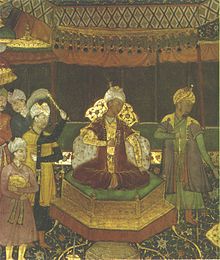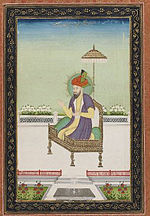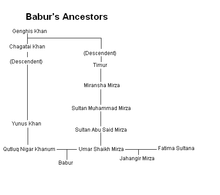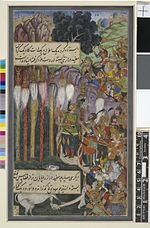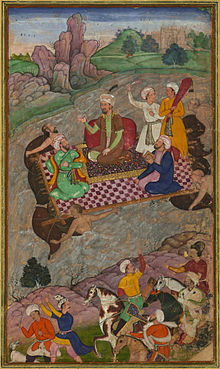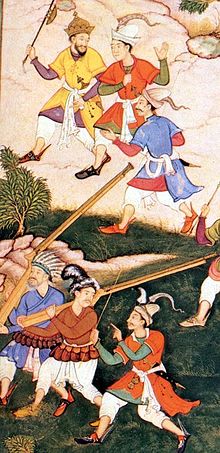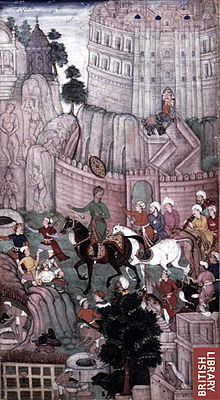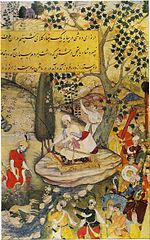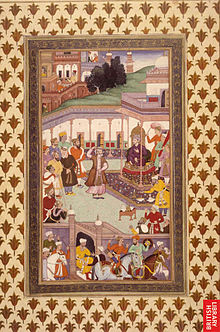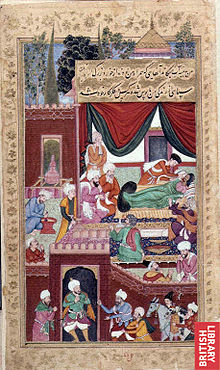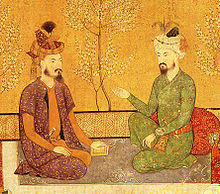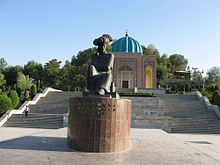
Babur
Background to the schools Wikipedia
SOS Children offer a complete download of this selection for schools for use on schools intranets. Before you decide about sponsoring a child, why not learn about different sponsorship charities first?
| Babur | |
|---|---|
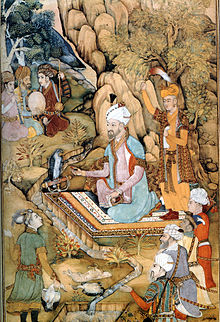 |
|
| A portrait of Babur, from an early illustrated manuscript of the Baburnama | |
|
|
|
| Reign | 30 April 1526 – 26 December 1530 |
| Predecessor | Ibrahim Lodi |
| Successor | Humayun |
| Spouse | Aisha Sultan Begum Zaynab Sultān Begum Maham Begum Dildar Begum Gulnar Aghacha Gulrukh Begum Mubarika Yousefzai |
| Issue | |
| Humayun, son Kamran Mirza, son Askarī Mirzā, son Hindal Mirzā, son Gulbadan Begum, daughter Fakhru 'n-Nīsā, daughter Altun Bishik, alleged son |
|
| Full name | |
| Zahir-ud-din Muhammad Babur Beg | |
| House | Timurid |
| Father | Umar Shaikh Mirza II, ʿAmīr of Farghana |
| Mother | Qutlugh Nigar Khanum |
| Born | 23 February 1483 Andijan, Uzbekistan |
| Died | 26 December 1530 (age 47) Agra, India |
| Burial | Kabul, Afghanistan |
| Religion | Islam |
|
|||||
Zahir-ud-din Muhammad Babur (14 February 1483 – 26 December 1530; sometimes also spelt Baber or Babar) was a conqueror from Central Asia who, following a series of setbacks, finally succeeded in laying the basis for the Mughal dynasty in the Indian Subcontinent and became the first Mughal emperor. He was a direct descendant of Timur through his father, and a descendant also of Genghis Khan through his mother; hence, he identified his lineage as Timurid and Chaghatay-Turkic. He was greatly influenced by Persian culture and this affected both his own actions and those of his successors, giving rise to a significant expansion of the Persianate ethos in the Indian subcontinent.
Etymology
Ẓahīr ad-Dīn Muḥammad ( Persian: ﻇﻬﻴﺮﺍﻟﺪﻳﻦ محمد, also known by his royal titles as al-ṣultānu 'l-ʿazam wa 'l-ḫāqān al-mukkarram bādshāh-e ġāzī), is more commonly known by his nickname, Bābur (بابر). He used the royal title of Padshah.
According to Stephen Frederic Dale, the name Babur is derived from the Persian word babr, meaning "tiger", a word that repeatedly appears in Firdawsī's Shāhnāma and had also been borrowed by the Turkic languages of Central Asia. This thesis is supported by the Royal Asiatic Society of Great Britain and Ireland, explaining that the Turko-Mongol name Timur underwent a similar evolution, from the Sanskrit word cimara ("iron") via a modified version *čimr to the final Turkicized version timür, with -ür replacing -r due to the Turkish vowel harmony (hence babr → babür).
Contradicting these views, W.M. Thackston argues that the name cannot be taken from babr and instead must be derived from a word that has evolved out of the Indo-European word for beaver, pointing to the fact that the name is pronounced bāh-bor in both Persian and Turkic, similar to the Russian word for beaver (бобр – bobr). Babur's cousin, Mirzā Muḥammad Haydar, said that
At that time the Chaghatái (descendants of Genghis Khan) were very rude and uncultured (bázári), and not refined (buzurg) as they are now; thus they found Zahir-ud-Din Muhammad difficult to pronounce, and for this reason gave him the name of Bábar. In the public prayers ( khutba) and in royal mandates he is always styled 'Zahir-ud-Din Bábar Muhammad,' but he is best known as Bábar Pádisháh.
Biography
Babur wrote his memoirs and these form the main source for details of his life. They are known as the Baburnama.
He wrote the Baburnama in Chaghatai Turkic, his mother-tongue, though his prose was highly Persianized in its sentence structure, morphology and vocabulary.
Early life
Babur was born on February 23 [ O.S. February 14] 1483 in the town of Andijan, in the Fergana Valley in contemporary Uzbekistan. He was the eldest son of Omar Sheykh Mirzā, ruler of the Fergana Valley, the son of Abū Saʿīd Mirza (and grandson of Miran Shah, who was himself son of Timur) and his wife Qutlugh Nigar Khanum, daughter of Yunus Khan, the ruler of Moghulistan (and great-great grandson of Tughlugh Timur, the son of Esen Buqa I, who was the great-great-great grandson of Chaghatai Khan, the second born son of Genghis Khan).
Although Babur hailed from the Barlas tribe which was of Mongol origin, his tribe had embraced Turkic and Persian culture, converted to Islam and resided in Turkestan and Khorasan. His mother tongue was the Chaghatai language (known to Babur as Turkī, "Turkic") and he was equally at home in Persian, the lingua franca of the Timurid elite.
Hence Babur, though nominally a Mongol (or Moghul in Persian language), drew much of his support from the local Turkic and Iranian people of Central Asia, and his army was diverse in its ethnic makeup. It included Persians (known to Babur as " Sarts" and " Tajiks"), ethnic Afghans, Arabs, as well as Barlas and Chaghatayid Turco-Mongols from Central Asia. Babur's army also included Qizilbāsh fighters, a militant religious order of Shi'a Sufis from Safavid Persia who later became one of the most influential groups in the Mughal court.
Babur is said to have been extremely strong and physically fit. He could allegedly carry two men, one on each of his shoulders, and then climb slopes on the run, just for exercise. He claimed to have swam across every major river he encountered, including twice across the Ganges River in North India. His passions could be equally strong. In his first marriage he was "bashful" towards Aisha Sultan Begum, later losing his affection for her. Babur also had a great passion to kill people, cut heads off people and create pillars out of the cut off heads. He claimed to have created several such pillars in his autobiography.
Though religion had a central place in his life, Babur also approvingly quoted a line of poetry by one of his contemporaries: "I am drunk, officer. Punish me when I am sober". He quit drinking alcohol before the Battle of Khanwa, only two years before his death for health reasons, and demanded that his court do the same. But he did not stop chewing narcotic preparations, and did not lose his sense of irony. He wrote, "Everyone regrets drinking and swears an oath (of abstinence); I swore the oath and regret that."
Babur's early relations with the Ottomans were very troubling because the Ottoman Sultan Selim I provided his arch rival Ubaydullah Khan with powerful matchlocks and cannons. In the year 1507, when ordered to accept Selim I as his rightful suzerain Babur refused, and gathered Qizilbash servicemen in order to counter the forces of Ubaydullah Khan during the Battle of Ghazdewan. In the year 1513, Ottoman Sultan Selim I reconciled with Babur (probably fearing that he would join the Safavids), dispatched Ustad Ali Quli the artilleryman and Mustafa Rumi the Matchlock marksman and many other Ottoman Turks, in order to assist Babur in his conquests. Thenceforth this particular assistance proved to be the basis of future Mughal-Ottoman relations.
Origins of the Mughal Empire
Military career
In 1495, at twelve years of age, Babur succeeded his father as ruler of Farghana, in present-day Uzbekistan. His uncles were relentless in their attempts to dislodge him from this position as well as many of his other territorial possessions to come. Thus, Babur spent a large portion of his life without shelter and in exile, aided by friends and peasants. In 1497, he besieged the city of Samarkand for seven months before eventually gaining control of it. Meanwhile, a rebellion amongst nobles back home approximately 350 kilometres (220 mi) away robbed him of Farghana. As he was marching to recover it, Babur's troops deserted in Samarkand, leaving him with neither Samarkand nor Fergana.
In 1501, he laid siege on Samarkand once more, but was soon after defeated by his most formidable rival, Muhammad Shaybani, khan of the Uzbeks. Samarkand, his lifelong obsession, was lost again. Escaping with a small band of followers from Fergana, for three years Babur concentrated on building up a strong army, recruiting widely amongst the Tajiks of Badakhshan in particular. In 1504, he was able to cross the snowy Hindu Kush mountains and captured Kabul from the Arghunids, who were forced to retreat to Kandahar. With this move, he gained a wealthy new kingdom and re-established his fortunes and assumed the title of Padshah. In the following year, Babur united with Sultan Husayn Mirza Bayqarah of Herat, a fellow Timurid and distant relative, against the usurper Muhammad Shaybani. However, the death of Sultan Husayn Mirza in 1506 delayed that venture. Babur instead stayed at Herat, spending just two months there before being forced to leave due to diminishing resources. Nevertheless, he marvelled at the intellectual abundance in Herat, which he stated was "filled with learned and matched men.", and became acquainted with the work of the Uzbek poet Mir Ali Shir Nava'i, who encouraged the use of Chagatai as a literary language. Nava'i's proficiency with the language, which he is credited with founding, may have influenced Babur in his decision to use it for his memoirs.
A brewing rebellion finally induced him to return to Kabul from Herat, Khorasan. He prevailed on that occasion, but two years later a revolt among some of his leading generals drove him out of Kabul. Escaping with very few companions, Babur soon returned to the city, capturing Kabul again and regaining the allegiance of the rebels. Meanwhile, Muhammad Shaybani was defeated and killed by Ismail I, Shah of Shia Safavid Persia, in 1510, and Babur used this opportunity to attempt to reconquer his ancestral Timurid territories. Over the following few years, Babur and Shah Ismail would form a partnership in an attempt to take over parts of Central Asia. In return for Ismail's assistance, Babur permitted the Safavids to act as a suzerain over him and his followers. Conversely, Shah Ismail reunited Babur with his sister Khānzāda, who had been imprisoned by and forced to marry the recently deceased Shaybani.
Conquest of the Lodi Empire
Writing in retrospect, Babur suggested his failure in attaining Samarkand was the greatest gift Allah bestowed him. Babur had now resigned all hopes of recovering Fergana, and although he dreaded an invasion from the Uzbeks to his West, his attention increasingly turned towards India and its lands in the east, especially the rich lands of the Delhi Sultanate.
Babur claimed to be the true and rightful Monarch of the lands of the Lodi dynasty. He believed himself the rightful heir to the throne of Timur, and it was Timur who had originally left Khizr Khan in charge of his vassal in the Punjab, who became the leader, or Sultan, of the Delhi Sultanate, founding the Sayyid dynasty. The Sayyid dynasty, however, had been ousted by Ibrahim Lodi, a Ghilzai Afghan, and Babur wanted it returned to the Timurids. Indeed, while actively building up the troop numbers for an invasion of the Punjab he sent a request to Ibrahim; "I sent him a goshawk and asked for the countries which from old had depended on the Turk," the 'countries' referred to were the lands of the Delhi Sultanate.
Following the unsurprising reluctance of Ibrahim to accept the terms of this "offer," and though in no hurry to launch an actual invasion, Babur made several preliminary incursions and also seized Kandahar — a strategic city if he was to fight off attacks on Kabul from the west while he was occupied in India – from the Arghunids. The siege of Kandahar, however, lasted far longer than anticipated, and it was only almost three years later that Kandahar and its Citadel (backed by enormous natural features) were taken, and that minor assaults in India recommenced. During this series of skirmishes and battles an opportunity for a more extended expedition presented itself.
Upon entering the Punjab plains, Babur's chief allies, namely Langar Khan Niazi advised Babur to engage the powerful and famous Muslim, Janjua Rajputs to join his conquest. The tribe's rebellious stance to the throne of Delhi was well known. Upon meeting their chiefs, Asad Malik Hast and Raja Sanghar Ali Khan, Babur made mention of the Janjua's popularity as traditional rulers of their kingdom and their ancestral support for his patriarch Timur during his conquest of the Tughluq dynasty. Babur aided them in defeating their enemies, the Gakhars in 1521, thus gaining their alliance. Babur then won their support and service during the Battle of Panipat and later on during the Battle of Khanwa. By that time the Lodi empire was also significantly weakened in Punjab-Rajasthan areas because of strong resistance from Rajputs especially Rana Sanga.
The section of Babur's memoirs covering the period between 1508 and 1519 is missing. During these years Shah Ismail I suffered a large defeat when his large cavalry-based army was obliterated at the Battle of Chaldiran by the Ottoman Empire's new weapon, the matchlock musket. Both Shah Ismail and Babur, it appears, were swift in acquiring this new technology for themselves. Somewhere during these years Babur introduced matchlocks into his army, and allowed an Ottoman, Ustad Ali, to train his troops, who were then known as Matchlockmen, in their use. Babur's memoirs give accounts of battles where the opposition forces mocked his troops, never having seen a gun before, because of the noise they made and the way no arrows, spears, etc. appeared to come from the weapon when fired.
These guns allowed small armies to make large gains on enemy territory. Small parties of skirmishers who had been dispatched simply to test enemy positions and tactics, were making inroads into India. Babur, however, had survived two revolts, one in Kandahar and another in Kabul, and was careful to pacify the local population after victories, following local traditions and aiding widows and orphans.
First battle of Panipat
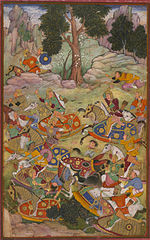
However, while the Timurids were united, the Lodi armies were far from unified. Ibrahim was widely detested, even amongst his nobles, and it was several of his Afghan nobles who were to invite Babur's intervention. Babur assembled a 12,000-man army, and advanced into India. This number actually increased as Babur advanced, as members of the local population joined the invading army. The first major clash between the two sides was fought in late February 1526. Babur's son, Humayun (then aged 17), led the Timurid army into battle against the first of Ibrahim's advance parties. Humayun's victory was harder fought than the previous skirmishes, but it was still a decisive victory. Over one hundred prisoners of war were captured along with around eight war elephants. However, unlike after previous battles, these prisoners were not bonded or freed; by decree from Humayun, they were shot. In his memoirs, Babur recorded that "Ustad Ali-quli and the matchlockmen were ordered to shoot all the prisoners, by way of example; this had been Humayun's first affair, his first experience of battle; it was an excellent omen!" This is perhaps the earliest example of execution by firing squad.
Ibrahim Lodi advanced against him with 100,000 soldiers and 100 elephants; and though Babur's army had grown, it was still less than half the size of his opponents, possibly as few as 25,000 men. This was to be their main engagement, the First battle of Panipat, and was fought on 21 April 1526. Ibrahim Lodi was slain and his army was routed; Babur quickly took possession of both Delhi and Agra. That very day Babur ordered Humayun to ride to Agra (Ibrahim's former capital) and secure its national treasures and resources from looting. Humayun found the family of the Raja of Gwalior there — the Raja himself having died at Panipat — sheltering from the invaders, fearing the dreadful nature of the 'Mongols' from the stories that preceded their arrival. After their safety was guaranteed they gave Humayun their family's most valuable jewel, a very large diamond, which some believe to be the diamond which came to be called the Koh-i-Noor or "Mountain of Light'. It is thought that they did this to retain their Kingdom. Whether it was because of the gift or not, the family remained the rulers of Gwalior, though now under their new rulers the Timurids.
Babur, meanwhile, marched onward to Delhi reaching it three days after the battle. He celebrated his arrival with a festival on the river Jumna, and remained there at least until Friday ( Jum'ah), when Muslim congregational prayers were said and he heard the Khutba, (sermon), read in his name in the Jama Masjid, a sign of the assumption of sovereignty. He then marched to Agra to join Humayun. Upon arrival Babur was presented with the fabulous diamond, and Babur reports that "I just gave it back to him", adding, "an expert in jewels said its value would provide two and a half days food for the whole world."
Battles with the Rajputs
Although master of Delhi and Agra, Babur records in his memoirs that he had sleepless nights because of continuing worries over Raja Hasan Khan, Mewatpatti (title, Lord of Mewat), the Khanzada ruler of Mewat, Rana Sanga, the Rajput ruler of Mewar.
In A.D. 1526 a new power appeared in India. Babur, who claimed to be the representative of Timur Lang, after winning the battle of Panipat, took possession of Dehli and Agra ; and determined that his enterprise should not be a mere raid like Timur's, but the foundation of a new and lasting empire. Then it was that the Rajputs made their last great struggle for independence. They were led by Rana Sanga, a chief of Mewar, who invited the Mewatti chief, Hasan Khan, to aid the nation from which he had sprung in resisting the new horde of Musalmans from the north.
The political position of Hasan Khan at this time was a very important one. Babur, in his autobiography, speaks of him as the prime mover in all the confusions and insurrections of the period. He had, he states, vainly shown Hasan Khan distinguished marks of favour, but the affections of the infidel lay all on the side of the natives i.e., the Hindus ( Indians ) ; and the propinquity of his country to Dehli, no doubt, made his opposition especially dangerous. Hasan Khan's seat at this time was at Ulwur, but local tradition says that he was originally established at Bahadarpur, eight miles from Ulwur.
Babur says that the ancestors of his opponent Hasan Khan had governed Mewat in uninterrupted succession for nearly 200 years, and that Tejara was their capital. In another place he calls him Raja Hasan Khan Mewati, an infidel, who was the prime mover and agitator in the insurrection against the Mughals. The title of Raja and the term " infidel " show that Babur was aware of Hasan Khan's Hindu descent, and the period of '* nearly 200 years" most probably refers to the date when his ancestor became a Muslim in the reign of Firoz Shah between A.H. 752 and 790.
The Rajput lords had, prior to Babur's intervention, succeeded in conquering some of the Sultanate's territory. They ruled an area directly to the southwest of Babur's new dominions, commonly known as Rajputana as well as fortified dominions in other parts of northern India. It was not a unified kingdom, but rather a confederacy of principalities, under the informal suzerainty of Rana Sanga, head of the senior Rajput dynasty.
The Rajputs had possibly heard word of the heavy casualties inflicted by Lodi on Babur's forces, and believed that they could capture Delhi, and possibly all Hindustan. They hoped to bring it back into Hindu Rajput hands for the first time in almost three hundred and fifty years since Sultan Shah-al Din Muhammad of Ghor defeated the Rajput Chauhan King Prithviraj III in 1192.
Furthermore, the Rajputs were well aware that there was dissent within the ranks of Babur's army. The hot Indian summer was upon them, and many troops wanted to return home to the cooler climes of Central Asia. The Rajputs' reputation for courage preceded them, and their superior numbers no doubt further contributed to the desire of Babur's army to retreat.According to Babur's own calculations the potential strength of the Rajput army was much larger than that deployed by the Lodis at Panipat. Babur resolved to make this an extended battle, and decided to push further into India, into lands never previously claimed by the Timurids. He needed his troops to defeat the Rajputs.
Despite the unwillingness of his troops to engage in further warfare, Babur was convinced he could overcome the Rajputs and gain complete control over Hindustan. He made great propaganda of the fact that for the first time he was to battle non-Muslims, the Kafir, to the extent of taking a vow to abstain from drinking (a common fraction among his people) for the rest of his life to win divine favour, and declared the war against Rana Sanga.
Death
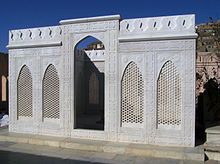
After Babur fell seriously ill, Humayun was told of a plot by the senior nobles of Babur's court to bypass the leader's sons and appoint Mahdi Khwaja, Babur's sister's husband, as his successor. He rushed to Agra and arrived there to see his father was well enough again, although Mahdi Khwaja had lost all hope of becoming ruler after arrogantly exceeding his authority during Babur's illness. Upon his arrival in Agra it was Humayun himself who fell ill, and was close to dying.
Babur died at the age of 47 on January 5 [ O.S. 26 December 1530] 1531, and was succeeded by his eldest son, Humayun. Though he wished to be buried in his favourite garden in Kabul, a city he had always loved, he was first buried in a mausoleum in the capital city of Agra. His remains were later moved to Bagh-e Babur (Babur Gardens) in Kabul, Afghanistan. The Persian inscription on his tomb there translates as "If there is a paradise on earth, it is this, it is this, it is this!
Legacy
Babur is considered a national hero in Uzbekistan and Kyrgyzstan, and is held in high esteem in Afghanistan. In October 2005 Pakistan developed the Babur (cruise missile), named in his honour.
F. Lehmann has said that
His origin, milieu, training, and culture were steeped in Persian culture and so Babur was largely responsible for the fostering of this culture by his descendants, the Mughals of India, and for the expansion of Persian cultural influence in the Indian subcontinent, with brilliant literary, artistic, and historiographical results.
Impact on architecture
Babur travelled the country, taking in much of the land and its scenery, and began building a series of structures which mixed the pre-existing Hindu intricacies of carved detail with the Muslim designs used by Persians and Turks. He described with awe the buildings in Chanderi, a village carved from rock, and the palace of Man Singh I in Gwalior. He, was, however, disgusted by the Jain " deities" carved into the rock face below the fortress at Gwalior. Fortunately, the statues were not destroyed entirely, rather the faces and genitalia of the offending pieces were removed. (Modern sculptors have restored the faces).
To remind himself of the beautiful women of the lands he had left behind, Babur began a process of creating exquisite gardens in every palace and province, where he would often sit with many concubines and perform sexual acts under the fierce Indian sun. Often getting heat stroke from exhausting himself in the heat. He tried to recreate the gardens of Kabul, which he believed were the most beautiful in the world, and in one of which he would eventually be buried. Almost thirty pages of Babur's memoirs are taken up describing the fauna and flora of his Hindustan.
Babri mosque
Babur is popularly believed to have demolished the Rama Temple at Ayodhya and built Babri Mosque in Ayodhya. However, from the three inscriptions which once adorned the surface of the mosque it becomes apparent that the mosque was constructed during his reign on the orders of Mir Baqi, who was one of the generals of Babur's forces sent towards this region. In 2003, The Archaeological Survey of India was asked to conduct a more in-depth study and an excavation to ascertain the type of structure that was beneath the rubble of Babri masjid. The summary of the ASI report indicated "no mention of a temple, only of evidence of a massive structure, fragments of which speak about their association with temple architecture of the Saivite style." It was destroyed in 1992 sparking off communal clashes around the country. resulting in the killing of thousands of Muslims and Hindus. Demolition of the Babri structure revealed remnants of prior Hindu construction within the walls of Babri. On 6 December 1992, Babri Masjid was demolished by Karsevaks of Ramajanmabhumi movement mobilised by the call given by organisations like VHP and Bajrangdal. LK Advani of BJP was a leading figure of the movement, along with several other saints and leaders of Hindu organisations.
